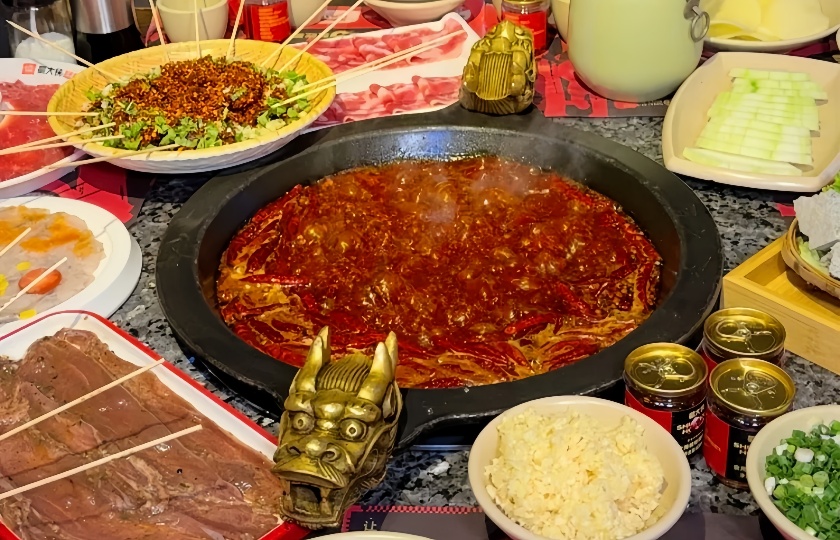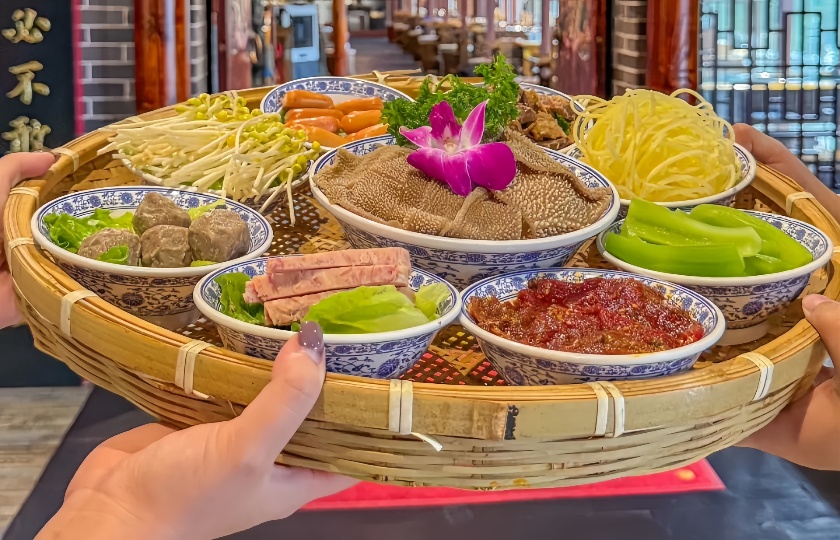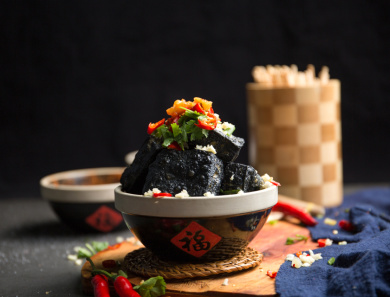A Gastronomic Exploration: What Is the Difference between Sichuan and Chongqing Hotpot?
 Sichuan and Chongqing hot pots are both famous for their spiciness. But what are the differences between Sichuan hot pot and Chongqing hot pot? Let's explore their unique charm and appreciate the different splendor of the hot pot world.
Sichuan and Chongqing hot pots are both famous for their spiciness. But what are the differences between Sichuan hot pot and Chongqing hot pot? Let's explore their unique charm and appreciate the different splendor of the hot pot world.
Broth Differences
Sichuan hot pot offers a variety of broths, including clear oil, beef tallow, and tomato. The clear oil broth, made with vegetable oil, is lighter and less likely to cause discomfort from heat, making it suitable for those who prefer milder flavors. It delivers a spicy yet refreshing taste, with the chili's heat balanced by the smoothness of the oil. In contrast, the beef tallow broth is rich and robust, packed with intense flavors that create a spicy feast for those who love bold tastes.
Chongqing hot pot primarily uses a beef tallow base. The generous amount of beef tallow creates a bubbling, aromatic broth known for its intense spiciness. This depth of flavor is perfect for those who love strong, spicy food. Each bite feels like a fiery explosion on the tongue, offering a thrilling experience.
Ingredient Differences
Sichuan hot pot is like a food festival with its diverse ingredients. Beyond the usual tripe, duck intestines, and beef, it includes seafood, vegetables, and tofu. The preparation is meticulous—tripe is sliced into large pieces for a tender crunch, and duck intestines are cleaned thoroughly to ensure the best texture in the hot pot. This variety satisfies different taste preferences, allowing diners to explore a range of delicious combinations.
Chongqing hot pot focuses on traditional ingredients like tripe, aorta, and goose intestines. Freshness and crispness are key, with strict selection criteria. The "seven up, eight down" method of cooking tripe is a classic technique, ensuring the perfect texture that complements the spicy broth. Goose intestines and aorta also offer unique, crunchy textures that shine in the Chongqing hot pot experience.
Dipping Sauce Differences
Sichuan hot pot offers a wide range of dipping sauces, such as sesame oil, dry spice mix, and sesame paste. The sesame oil sauce cools and reduces the heat, providing a smooth coating that enhances the texture of the food. The dry spice mix is bold and aromatic, with chili powder and crushed peanuts adding depth, creating a burst of flavor with every bite. The sesame paste is perfect for those who prefer less spice, offering a rich, creamy taste that balances the hot pot's heat.
Chongqing hot pot typically uses simple sauces like sesame oil and garlic. The sesame oil adds smoothness, while the garlic enhances the aroma. This simplicity highlights the natural flavors of the ingredients and the spicy broth, allowing for a pure and memorable taste experience.
No matter which hot pot you choose, you'll enjoy the unique allure of this beloved culinary tradition.
How spicy is Chongqing?
Chongqing's spice levels are clearly categorized, typically divided into the following levels:
12 Degrees - Mild (Kid-Friendly Spice): This is the entry-level spice, relatively mild with a hint of heat. It's suitable for those who can't handle much spice, like children or people with a low tolerance. For tourists trying Chongqing cuisine for the first time who want a touch of spice without overwhelming heat, this is a great choice.
36 Degrees - Easygoing Spice (Low Spice): Perfect for those who occasionally enjoy spicy food. This level offers a noticeable but not overwhelming heat, allowing you to savor the unique flavor of chili without overwhelming your taste buds.
45 Degrees - Authentic Spice (Medium Spice): This is the standard spice level in Chongqing, ideal for regular spice eaters. It provides a strong, stimulating heat that creates a warm sensation in the mouth. For locals, this is a common level that showcases the true essence of Chongqing cuisine.
52 Degrees - Bold Spice (High Spice): At this level, the spice becomes more intense, delivering a powerful kick. The chili's heat is fully unleashed, creating a burning sensation from the tongue to the throat. It's perfect for those who crave a higher level of spiciness.
65 Degrees - Chongqing Thrill (Extra Spicy): This falls into the extra spicy category, suitable only for true spice enthusiasts. It delivers a massive impact on the taste buds, with each bite setting your mouth ablaze. It might even make you break a sweat, but for those who love pushing the limits, this level offers immense satisfaction.
75 Degrees - Hot Pot Hero (Extreme Spice): This is a challenge for the brave, the highest level of spice. It's almost at the limit of human tolerance. Even seasoned Chongqing locals rarely attempt this level, as it's intensely hot and not for the faint-hearted.

Are you supposed to eat the soup in Hotpot?
For the sake of our health, it's generally advisable not to drink the broth from hot pot.
From the Perspective of Ingredients:
Purine Release: Various ingredients like meats (beef, lamb, pork), seafood (shrimp, crab, shellfish) release purines when cooked at high temperatures. Purines metabolize into uric acid in the body, which can significantly raise uric acid levels for individuals with hyperuricemia or gout, potentially exacerbating their condition and causing joint pain.
High Fat Content: Many hot pot bases contain a lot of fat, and the cooking process adds even more fat from the ingredients. Excessive fat intake can increase the risk of obesity, high cholesterol, and other related diseases. For instance, beef tallow hot pot has a thick layer of fat that can be quite "guilty" to consume.
Nitrite Concerns: Vegetables and other ingredients can produce nitrites during cooking, especially if cooked for a long time. Nitrites can be harmful to the body.
From the Perspective of Hot Pot Base:
Spices and Chili Stimulation: Hot pot bases usually contain a lot of spices and chili, making the broth very stimulating. Drinking such broth can burden the digestive system, causing stomach pain, diarrhea, and other discomforts. This is particularly true for people with sensitive stomachs, who should avoid hot pot broth.
Additive Risks: Some hot pot bases may contain food additives. While safe within regulated limits, consuming the broth means ingesting relatively higher amounts of these additives, which could be harmful in the long run.
Special Cases:
Light and Healthy Hot Pot: If the hot pot is made with a light broth using bones, vegetables, and mushrooms, without adding too much meat or seafood, and if it hasn't been cooked for too long, it might be okay to drink a little broth. However, moderation is key, as even light broths can develop some harmful substances if cooked for too long.
Cooking Tips and Precautions:
If you really want to taste the broth, you can ladle out a small bowl at the beginning of the cooking process, but avoid drinking too much.
While enjoying hot pot, drink plenty of plain water or tea to help with digestion and to counteract the richness of the food.
Which Chinese cuisine is the spiciest?
When it comes to the spiciest cuisine in China, Sichuan and Hunan cuisines are top contenders.
Sichuan Cuisine
Features: Known for its wide variety of ingredients and diverse flavors, Sichuan cuisine uses a lot of chili peppers, black pepper, and Sichuan peppercorns. It offers complex flavors like yuxiang (fish-fragrant), mala (numbing and spicy), and more. The spiciness is rich and varied, providing a strong sensory experience.
Who Will Love It: Perfect for those who enjoy bold flavors and spicy heat.
Hunan Cuisine
Features: Hunan cuisine is known for its meticulous preparation and diverse flavors. It’s characterized by heavy use of oil and a focus on fresh, fragrant, and spicy flavors. The spiciness in Hunan dishes is more straightforward and intense.
Who Will Love It: Ideal for those who can handle heat and crave a hearty, spicy taste.
Other Spicy Cuisines
Gan Cuisine: Jiangxi cuisine, also known as Gan cuisine, is famous for its spicy dishes as well.
Ultimately, declaring one cuisine as the "spiciest" is subjective, as everyone has different tastes and tolerance levels for spice.

What kind of meat does Hotpot use?
When it comes to choosing meat for hot pot, there are so many options to explore! Here are some popular choices:
Red Meat and Poultry
Beef: A star in hot pot! Different cuts like brisket, shank, and tongue each offer unique textures. Especially popular is marbled beef, which is tender and perfect for hot pot.
Lamb: Another classic choice. Cuts like leg and shoulder are tender and balanced in fat, making them ideal for both spicy and mild broths.
Pork: Essential in hot pot. Cuts like pork belly, neck, and tenderloin are delicious, with pork belly being especially flavorful after cooking.
Chicken: Well-loved for hot pot. Breast, wings, and thighs provide a smooth and tasty experience.
Duck: Options like duck intestines and boneless duck feet are tasty choices, offering a crunchy or chewy texture.
Seafood
Fish Fillets: Common in hot pot. Varieties like grass carp, bass, and snakehead are sliced thin for a tender and delicate taste.
Shrimp: Shrimp balls and fresh shrimp are great additions. They’re sweet, high in protein, and become even more flavorful when cooked.
Other Seafood: Eel, cuttlefish, abalone, scallops, and mussels are popular for their rich taste and nutritional value.
Other Meats
Offal: Options like pork liver, pork aorta, and beef tripe are unique and beloved for their texture and flavor in both spicy and mild broths.
Meatballs: Beef, fish, and shrimp balls are bouncy and delicious, perfect with any broth or dipping sauce.
In summary, there’s a wide variety of meats for hot pot, each with its own texture and nutritional benefits. Choose based on your taste and preferences!
What to cook first in hotpot?
Starting with potatoes is always a safe bet. Potatoes are quite resilient and take a while to cook. Placing them in the pot early allows them to slowly simmer in the hot broth. Over time, they become tender and soft, breaking apart easily with chopsticks. When cooked to this level, potatoes absorb the rich flavors of the broth, providing a melt-in-your-mouth experience that's incredibly satisfying.
Lotus root slices are also great to cook first. They have a unique, crunchy texture that becomes more flavorful after simmering in the hot pot. They retain their crispiness while soaking up the broth, making them a delightful addition to both spicy and mild hot pots.
Meatballs are another excellent choice. Beef balls, fish balls, and similar items are quite durable in the hot pot. As they cook, they absorb the broth, becoming juicy and flavorful. Biting into a well-cooked meatball releases a burst of savory broth, making them irresistible. Plus, with a variety of meatballs available, you can choose different flavors to keep things interesting.
Mushrooms are also perfect to cook early. Shiitake mushrooms, with their rich flavor, become even more aromatic the longer they cook. Enoki mushrooms, on the other hand, cook quickly and add a smooth texture to the hot pot. Combining these mushrooms with other ingredients enhances the overall flavor profile of the hot pot.
In summary, starting with these sturdy ingredients not only enhances the flavor of the broth but also builds anticipation for the rest of the meal.























